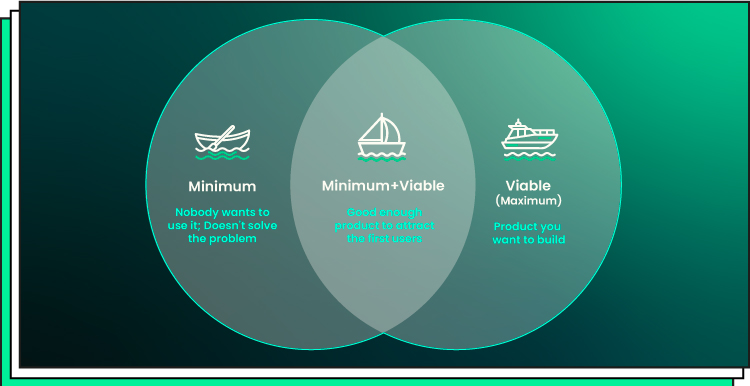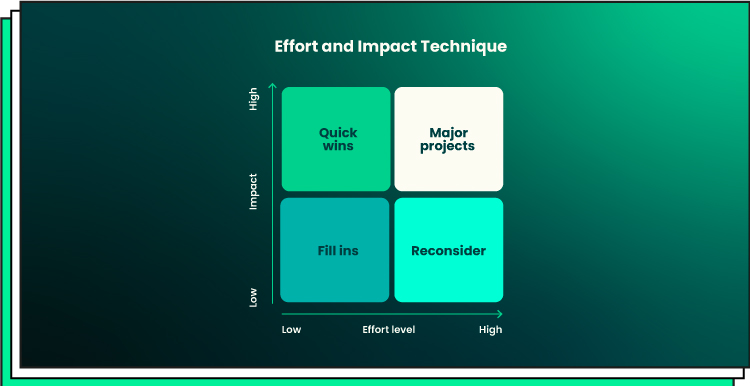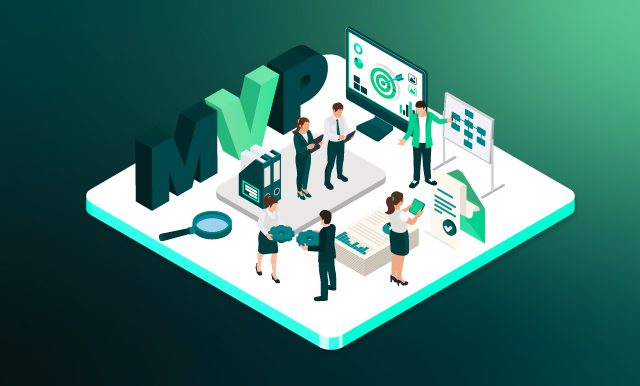MVP approach gains much popularity today as it helps businesses build high-demand solutions that meet client needs. However, MVP meaning in software development sometimes confuses those aiming to enter the market or launch a new startup. Today, we will figure it all out.
Starting a new business around a product or service is a brave decision. To get the best return, you should mitigate the risks and plan out the software development process meticulously. Many companies manage to do so. As the numbers show, more than 33% of successful startups started with a budget of less than $5,000. Due to the effective growth strategy, they managed to grow into popular and evergreen companies.
Still, investing the whole budget into a single solution seems a risky decision. Particularly, when you try to introduce something brand-new to the market. It’s like jumping into the water without knowing how deep the water is. Admit it, it would be much easier to jump if you tested the water before and understood how deep the bottom is. In this regard, the MVP approach is like the chance to “test the water” before a running jump.
In this piece, we will discuss MVP meaning in software context, outline the main MVP benefits and best practices, and try to inspire you with a few successful MVP stories. Keep reading to decide if you should move to full-scale software development or protect your budget and start with MVP.

MVP Meaning in Software Development
Let’s answer the question “What is an MVP?” first. MVP stands for Minimum Viable Product. It is the test version of your product that contains only basic features and functions. MVP in software development is created at the early project stages to test the viability of a product idea. After the minimum viable product is released, the development team collects feedback from the end users and observes how they interact with the product. The data collected at this stage is used to improve and enhance the solution and increase its value. Also, by creating MVPs, you can attract the attention of the first users and put effort into retaining them.
MVP vs. Prototype: What’s the Difference?
Now, we know what MVP in software development is. Let’s differentiate it from the related software engineering term.
When talking about MVP vs. prototype comparison, we’ll focus on the purpose. The goal of MVP is to determine if a product is viable and what features best meet user needs. Meanwhile, prototypes are built to visualize what is already planned out and give the team a basic understanding of what the solution will look like. Another difference between prototype and MVP is that MVPs are accessed by end users who can interact with the product. As a rule, a prototype is created only for internal use by the development team.
MVP Approach Benefits
After discussing the MVP software meaning, it’s important to look at the benefits it can bring. Here are the main ones:
Give your users what they want
Offering a good product does not always mean solving client pains. Clients will not pay for products or services just because they are nice — they want their problems to be solved. The MVP concept gives you such a chance. Instead of offering clients what you think they want, you can figure out precisely what they want. Based on the data you collect, you will build elements and features your users need.
Receive feedback
If you hear the voice of your clients, you increase the chances that your customers will stay with you for a long time. Receiving feedback about the MVP in software development is a great opportunity to communicate with your target audience and understand them better. After you look at your product from the real user’s perspective and put yourself in the client’s shoes, you will clearly see what features your product lacks and what your strong sides are.
Save money and time
Launching large software development projects means investing a lot of money, time, and effort into the product. Sometimes, it can take years to bring your vision into reality. But not all businesses have so many resources to put at stake. This is why choosing the MVP approach is a smarter decision that allows you to create a product faster and cheaper and improve the product idea before investing the whole budget into it.
Convince investors
The MVP approach can help you convince your investors that your business idea is worth supporting. It’s harder to do it with the help of assumptions only. If you have data at hand proving users like your software product, it’s much easier to find funds for growing it into a full-scale business. By building a minimum viable product (MVP), you can show all the value that your product brings to the market.
Test your product idea before implementing it
Imagine you started software development, created a product, spent several months promoting it, and only a year later found out that your solution wasn’t what users wanted. To prevent this from happening, you can start by building a minimum viable product. You will spend much less time and effort creating it and quickly figure out if there is a demand for such a product. If so, you can safely start developing a full-scale app or site.
Scale easily
It’s safer for your budget to grow from a one-feature page or solution to a full-fledged product than to build all the features at once and then start removing the irrelevant or useless ones. A minimum viable product (MVP) will help you scale easily as you’ll add new features and functionality your users will request.

What Makes a Good MVP?
The MVP approach can have many elements and features. As a dedicated software development partner, we will plan out the process according to your budget and expectations.
If you decide to create MVP on your own, check some of the characteristics that will help you define what a good MVP is:
- Simplicity. After you discover the MVP software meaning, you’ll see that it doesn’t contain all the features you want to see in your product. When creating an MVP, focus only on the main and basic functionality that will lie at the core of your software product.
- Purpose. MVPs should be developed with a purpose. For example, to define the perfect client, test the idea’s viability, prioritize the right features, etc.
- User need. Like the final product, MVP should meet user needs. By defining the needs, it will be easier for you to decide on the core functionality and features of your solution.
- Possibility of errors. No one says that an MVP should be perfect. It may and even should contain imperfections that might be discovered later. These imperfections will give you precious insights into possible improvements to the final product.
MVP Development for Startups: Best Practices
Now you know the answer to the question “What is MVP in software development?” At this step, we should move to the MVP creation checklist. It’s pretty simple. First, you should conduct market research to decide on the core features and plan out the product development. Then, you will choose the development tools, technologies, and means for creating MVP. Lastly, you launch your MVP, expose it to your target audience, and collect data to improve and enhance the solution.
When picking the most important features for your product, you may need to refer to the best MVP practices. These are:
- User journey mapping. In this practice, you will define the user goal and break it down into actionable steps (and substeps if needed). If the step cannot be skipped, it means that this feature or function is an important one and is worth adding to your MVP checklist.
- Prioritization. Try to prioritize the features numerically rating them from 1 to 3. The number 1 priority group will include the most critical features (ones that the audience uses to complete their goal). Number 2 will stand for the moderate features (ones that increase user engagement or performance or open extra revenue opportunities). Number 3 will cover the optional features (ones that users do not expect but that make the app more attractive).
- Effort & impact technique. This method is very useful when exploring the MVP software meaning. It enables you to evaluate the features based on the effort needed to build them and the impact they make on the target audience and product. The analysis is done in a matrix, which helps you quickly sort the features out by importance. Check it out below:

Successful MVP Startups: 3 Real-Life Examples
Is MVP development for startups only? Not necessarily. For startups, it’s a good chance to test the success and viability of an idea without investing the whole budget into a full-scale product. Investing in MVP though does not mean that you are doomed to stay on the startup level forever. We can share many examples of MVP startups that successfully grew into big businesses. Let’s check a few of them:
Spotify
This is one of the well-known examples when talking about MVP development for startups. Back in 2006, no one was interested in streaming services as music was easily accessible via torrent websites like Pirate Bay or LimeWire. Daniel Ek and Martin Lorentzon decided to change this tendency and launch a free streaming application where users would watch ads and listen to music for free in return. But it was important to test this idea first.
For this, Ek and Lorentzon built a very basic desktop app that had 1 main feature — music streaming. After the app started gaining popularity, the founders added several new features and paid/free options to choose from. If they offered a paid option right from the start, it could scare away all users who did not get used to paying for music. This is how MVP helped their company grow into a leading streaming service globally.
Airbnb
Another example of MVP development for startups was Airbnb. Sometimes, what we know as a successful business story has started as a small MVP project. Interestingly, startup owners may never call their project “MVP,” but their approach to the development process and scaling allows us to certainly call it a minimum viable product after years. The same happened to Airbnb which started as a basic MVP and then turned into a big enterprise.
Airbnb founders had a good idea for a website where people could rent and rent out apartments. However, they lacked an understanding of the market and weren’t sure if the user needed such a solution. To check it in practice, the founders decided to rent out their own apartments and create a site to promote this service.
They invested money into the creation of a basic site with limited features to check if they needed to keep going. The team quickly found out that there was a demand for such a product. Soon, the founders decided to invest their money into the full-scale website development process. This is how the MVP helped Airbnb founders gain confidence in their website idea and build a solution the user needs.
Facebook was launched 3 years after Frank Robinson coined the term “MVP” in 2001. As you may guess, the term was not so popular yet. But the basic rules of MVP creation were intuitively followed by people working in the tech sphere. Facebook is one of the examples of MVPs in the period when little was known about the very term.
Initially, the Facebook founders decided to build a simple solution that would help university students connect. They chose a perfect target audience and got insightful feedback about their network. Based on this feedback, they started to scale the solution by adding new features and attracting a bigger audience.
Conclusion on MVP in Software
In this article, we’ve answered the question “What is MVP in software?” Besides, we discussed MVP’s benefits and must-have features to help you save your budget and improve the initial idea. If you have some questions left, do not hesitate to contact our team.
Forbytes is a trusted software partner that never rushes into the software development process. Before creating software, we carefully study your goals, demands, and market conditions. In case we need more data on the viability of your business idea, we will advise you to start with MVP and will plan this process out. The MVP approach helps us move smoothly from small to big and improve the software product as per user feedback. If you are determined to join the list of successful project cases, we will gladly help.

Our Engineers
Can Help
Are you ready to discover all benefits of running a business in the digital era?

Our Engineers
Can Help
Are you ready to discover all benefits of running a business in the digital era?









